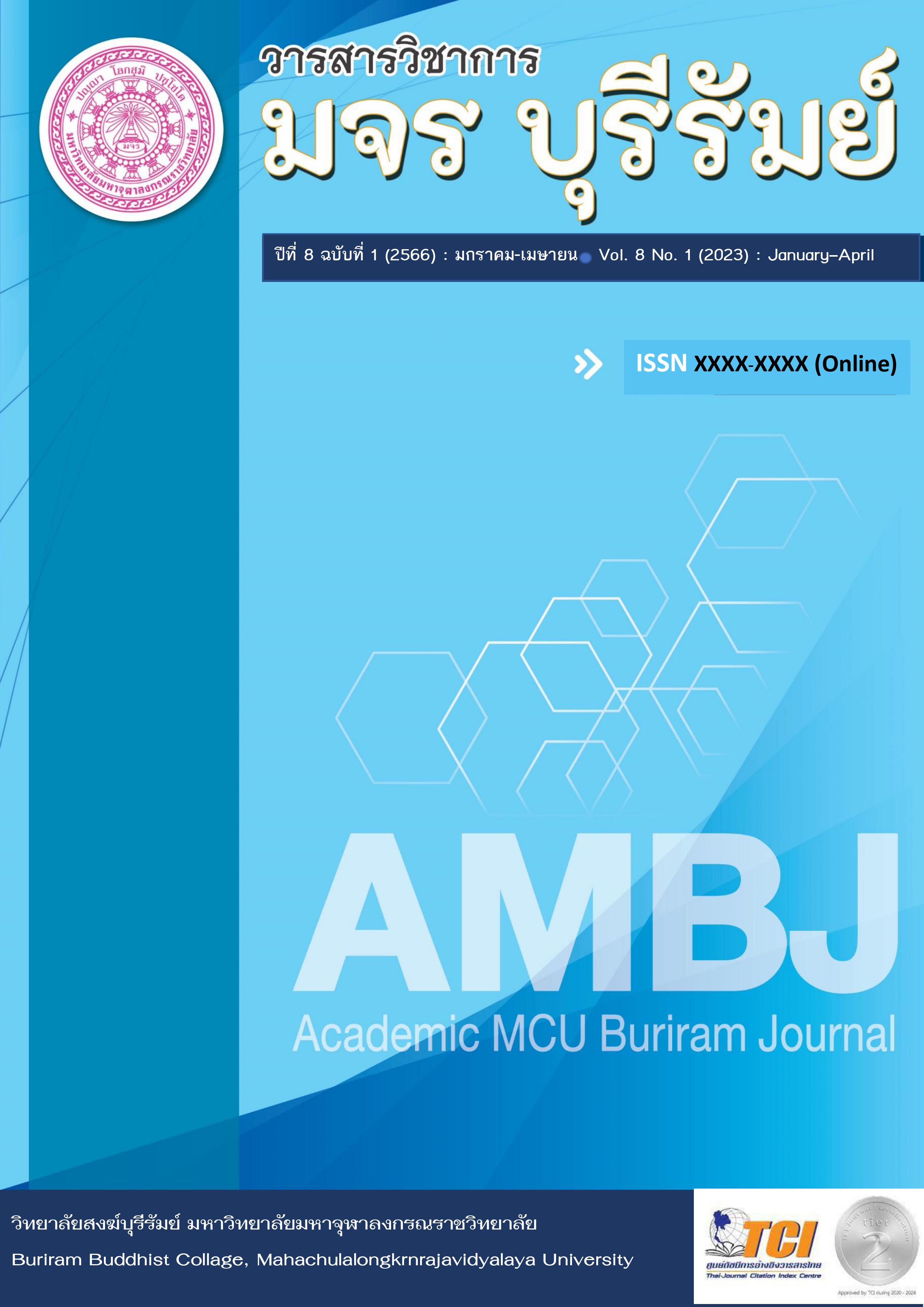The Development of 5-Dimensional Leadership Model of School Administrators under the Office of the Private Education Commission
Keywords:
5-Dimensional leadership, School administrators, Office of the Private Education CommissionAbstract
The purpose of this research were: 1) to study the 5-dimensional leadership model of school administrators under the Office of the Private Education Commission, 2) to evaluate the feasibility and utilization of the 5-dimensional leadership model of school administrators under the Office of the Private Education Commission. The target group was 30 school administrators under the Office of the Private Education Commission. The research was conducted in 2 steps as follows: Step 1: Developing 5-dimensional leadership model of school administrators under the Private Education Commission. Step 2: Evaluating the feasibility and utilization of the 5-dimensional leadership model of school administrators under the Private Education Commission. The statistics used for data analyses were obtained from studying related documents, books, journals and research, and comments from expert group discussions were analyzed by content analysis IOC (Index of Item - Objective Congruence) percentage, mean and Standard Deviation.
The research results found that:
1. The 5-dimensional leadership model of school administrators under the Office of the Private Education Commission was appropriate and accurate, consisted of 5 aspects: 1) Having vision with 10 items, 2) Having personnel participation with 7 items, 3) Building relationship with personnel with 10 items, 4) Coaching with 12 items, and 5) Monitoring with 9 items. Totally 48 items.
2. The results of the evaluation of the feasibility and utilization as a whole had the feasibility at the high level. They were arranged in descending order of mean as follows: 1) Having vision, 2) Building relationship with personnel, 3) Having personnel participation, 4) Coaching, and 5) Monitoring. The evaluation results of the level of utilization as a whole had the utilization at the high level. When considered individual aspects found that Having vision were at the high level. The other were arranged in descending order; 1) Building relationship with personnel, 2) Having personnel participation, 3) Coaching, and 4) Monitoring.
References
กำพล วิลยาลัย. (2557). รูปแบบการกำกับติดตามการบริหารแบบมุ่งผลลัพธ์ของสถานศึกษา สังกัดสำนักงานเขตพื้นที่การศึกษามัธยมศึกษา. ปริญญานิพนธ์ปริญญาศึกษาศาสตรดุษฎีบัณฑิต สาขาวิชาการบริหารการศึกษาและผู้นำการเปลี่ยนแปลง. มหาวิทยาลัยอีสเทิร์เอเชีย.
กัลยา สรรพกิจโกศล. (2558). รูปแบบการพัฒนาภาวะผู้นำสู่โลกสากลของผู้บริหาร บริษัทในกลุ่มอุตสาหกรรมส่งออกอาหารของของประเทศไทย. ปริญญานิพนธ์ปริญญาปรัชญาดุษฎีบัณฑิต สาขาวิชาการพัฒนาทรัพยากรมนุษย์. มหาวิทยาลัยรามคำแหง.
วิทยา เกริกศุกลวณิชย์. (2557). กระบวนการเชิงระบบในการกำกับติดตามการดำเนินงานตามนโยบายของโรงเรียนมัธยมศึกษา. ปริญญานิพนธ์ปริญญาศึกษาศาสตรดุษฎีบัณฑิต. มหาวิทยาลัยศิลปากร.
วิทยากร เชียงกูล. (2553). ปฏิรูปประเทศไทย. กรุงเทพฯ: บ้านพระอาทิตย์.
เสริมศักดิ์ วิศาลาภรณ์. (2539). ทักษะที่จำเป็นสำหรับผู้บริหารสถานศึกษา. เอกสารประกอบการสอน. กรุงเทพฯ: บัณฑิตวิทยาลัย มหาวิทยาลัยศรีนครินทรวิโรฒ.
สมชาย เทพแสง และ อรจิรา เทพแสง. (2549). ผู้นำยุคใหม่: หัวใจของการปฏิรูป. นนทบุรี: เกรทเอ็ดดูเคชั่น.
สุชาติ ทองมา. (2560). รูปแบบภาวะผู้นำที่ส่งผลต่อประสิทธิผลการบริหารงานวิชาการของผู้บริหารสถานศึกษา สังกัดสำนักงานคณะกรรมการศึกษาขั้นพื้นฐาน. ปริญญานิพนธ์ปริญญาครุศาสตรดุษฎีบัณฑิต สาขาวิชาการบริหารการศึกษา. มหาวิทยาลัยราชภัฎพระนครศรีอยุธยา.
อาภรณ์ ภู่วิทยพันธุ์. (2562). บทความสอนงาน. เข้าถึงได้จาก https://www.dol.go.th /train/Pages/Coaching1.aspx (สืบค้นเมื่อ 15 พฤศจิกายน 2562).
Bass, Bernard. (1990). From transactional to transformational leadership: learning toShare the Vision. Organizational Dynamics, 18 (3), 19-31.
Bird, A. (2013). Mapping the content domain of global leadership competencies. In Global leadership: Research, practice and development, 10(2), 80-96. New York. NY: Routledge.
Bennis, Warren and Nanus, Burt. (1997). Leaders. New York: Happer Collins Publishers.
Campbell, Scott and Samiec,Ellen. (2000). 5 D Leadership: Key Dimensions for Leading in the Real World. London: Sage.
Dess, G. and Pickens, J. C. (2000). Changing Roles: Leadership in the 21st Century. Organizational Dynamics, 3(28), 18 – 34.
Garrison, Mark., and Bly, Margaret, Anne. (1997). Human Relations. Boston:
Koteva Mojsovski, Tatjana. (2015). Posibilities of teacher for monitoring detecting and Recording of individual characteristices of student in school age. International Journal of Cognitive Research in Science Engineering and Education, 3(1), 1-6.
Pinder, C. C. (2008). Work Motivation in Organizational Behavior. (2nd ed). New York: Psychology Press.
Prasanth, Abilesh, J. (2017). 5 Dimension Leadership. Scribd journal, 5(1), 1-5.
Stebbins S, Molly. (2012). Monitoring the Effectiveness of the Wilson Reading System for Students with Disabilities: One District's Example. Research Gate Journal, 20(1), 58-70.
Downloads
Published
How to Cite
Issue
Section
License
Copyright (c) 2023 Academic MCU Buriram Journal

This work is licensed under a Creative Commons Attribution-NonCommercial-NoDerivatives 4.0 International License.
ทัศนะและความคิดเห็นที่ปรากฏในบทความวารสารฉบับนี้ถือเป็นความรับผิดชอบของผู้เขียนบทความนั้น ไม่ถือเป็นทัศนะและความรับผิดชอบของบรรณาธิการ





